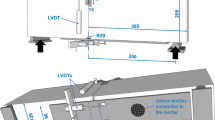Abstract
The behaviors of concrete at elevated curing temperature were studied. The test results show that when concrete is cured at elevated temperature, a harmful consequence occurs. The later strength decreses significantly compared to that under normal curing condition. Incorporating silica fume, fly ash and slag or lowering w/c ratio can effectively alleviate this harmful consequence. Comparatively, incorporation of silica fume is the most efficient means to decrease the later strength reduction. The harmful consequence is not caused by the difference in degree of hydration since the degree of hydration is similar between elevated curing temperature and normal curing condition. The SEM analysis shows that it is the uneven distribution of hydration products caused by elevated curing temperature that leads to the later strength reduction of concrete.
Similar content being viewed by others
References
Kefeng Tan, Gj O E. Performance of Concrete under Different Curing Conditions.Cement and Concrete Research, 1996, 26(3): 335–361
Escalante-Garcia J I, Sharp J H. The Microstructure and Mechanical Properties of Blended Cements Hydrated at Various Temperatures.Cement and Concrete Research, 2001, 31(5):695–702
Paul M and Glasser F P. Impact of Prolonged Warm (85 °C) Moist Cure on Portland Cement Paste.Cement and Concrete Research, 2000, 30(12):1869–1877
Verbeck G J, Helmuth R H.Structure and Physical Properties of Cement Paste. Proceeding of the 5th International Congress on the Chemistry of Cement, Tokyo, 1968
Older I, Skalny J. Hydration of Tricalcium Silicate at Elevated Temperatures.Journal of Applied Chemistry, Biotechnology, 1973, (23):37–45
Skalny J, Older I. Porestructure of Hydrated Calcium Silicates III. Influence of Temperature on the Pore Structure of Hydrated Tricalcium Silicate.Journal of Colloid and Interface Science, 1972, 40(2):156–163
Regourd K M, Gautier E. Comportement Des Coments Soumis au Durcissement Accéléré, Ciments, Bétons Platres Chaux, 1980, (4):374–383
Kiellsen K O.Physical and Mathematical Modeling of Hydration and Hardening of Portland Cement Concrete as a Function of Time and Curing Temperature: [Ph D thesis]. Norwegian University of Technology, 1992
Author information
Authors and Affiliations
Additional information
TAN Ke-feng: Born in 1957
Rights and permissions
About this article
Cite this article
Ke-feng, T., Nichols, J.M. Performances of concrete under elevated curing temperature. J. Wuhan Univ. Technol.-Mat. Sci. Edit. 19, 65–67 (2004). https://doi.org/10.1007/BF02835064
Received:
Accepted:
Issue Date:
DOI: https://doi.org/10.1007/BF02835064




